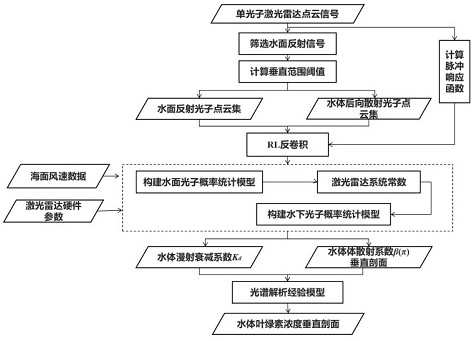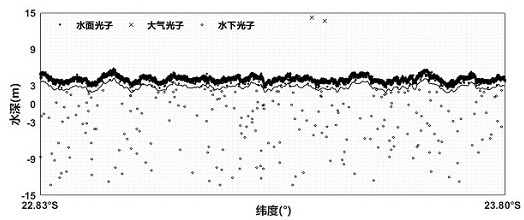Chlorophyll concentration vertical profile inversion method of satellite-borne single-photon laser radar
A technology of chlorophyll concentration and laser radar, which is applied in the field of laser remote sensing, can solve the problems of inability to record signal size, after-pulse effect, etc.
- Summary
- Abstract
- Description
- Claims
- Application Information
AI Technical Summary
Problems solved by technology
Method used
Image
Examples
Embodiment Construction
[0046] Below in conjunction with specific embodiment the present invention is described in further detail:
[0047] The steps of the present invention are as figure 1 , taking the photon point cloud data and system hardware parameters acquired by the US ICESat-2 (Ice, Cloud, and land Elevation Satellite-2) single-photon lidar as an example. ICESat-2 is the world's first satellite equipped with a single-photon laser radar system. It carries a single-photon laser radar named ATLAS (Advanced Topographic Laser Altimeter System), which is equipped with three strong beams and weak beams in the direction perpendicular to the satellite orbit. Six topographic profiles can be constructed with a vertical accuracy of tens of centimeters. At the same time, the footprint size of the single-photon lidar point cloud, the point cloud density in the along-track direction (along the satellite flight direction) and vertical track direction (perpendicular to the satellite flight direction) are g...
PUM
 Login to View More
Login to View More Abstract
Description
Claims
Application Information
 Login to View More
Login to View More - R&D
- Intellectual Property
- Life Sciences
- Materials
- Tech Scout
- Unparalleled Data Quality
- Higher Quality Content
- 60% Fewer Hallucinations
Browse by: Latest US Patents, China's latest patents, Technical Efficacy Thesaurus, Application Domain, Technology Topic, Popular Technical Reports.
© 2025 PatSnap. All rights reserved.Legal|Privacy policy|Modern Slavery Act Transparency Statement|Sitemap|About US| Contact US: help@patsnap.com



